UNITED STATES
SECURITIES AND EXCHANGE COMMISSION
Washington, D.C. 20549
FORM N-CSR
CERTIFIED SHAREHOLDER REPORT OF REGISTERED
MANAGEMENT INVESTMENT COMPANIES
Investment Company Act File Number: 811-05833
| T. Rowe Price Institutional International Funds, Inc. |
|
| (Exact name of registrant as specified in charter) |
| |
| 100 East Pratt Street, Baltimore, MD 21202 |
|
| (Address of principal executive offices) |
| |
| David Oestreicher |
| 100 East Pratt Street, Baltimore, MD 21202 |
|
| (Name and address of agent for service) |
Registrant’s telephone number, including area code: (410) 345-2000
Date of fiscal year end: October 31
Date of reporting period: October 31, 2016
Item 1. Report to Shareholders
| Institutional Frontier Markets Equity Fund | October 31, 2016 |
| ● | Frontier equity markets, as measured by the MSCI Frontier Markets Index, were flat in the last six months and declined in U.S. dollar terms for the year ended October 31, 2016.
|
| ● | Your fund significantly outperformed the index in both periods. Favorable stock selection, especially in Vietnam and, to a lesser extent, Sri Lanka, was the driving factor behind our outperformance.
|
| ● | Asian markets remain our favorites in the frontier universe, as they offer excellent mixes of economic growth, increasing consumption, and quality companies, many of which are trading at attractive valuations. Argentina also typifies our case for frontier markets investing.
|
| ● | We are pleased with our research-driven relative performance over the last year and believe that there is enough encouraging news flow to remain positive on near- and longer-term prospects for frontier markets. |
The views and opinions in this report were current as of October 31, 2016. They are not guarantees of performance or investment results and should not be taken as investment advice. Investment decisions reflect a variety of factors, and the managers reserve the right to change their views about individual stocks, sectors, and the markets at any time. As a result, the views expressed should not be relied upon as a forecast of the fund’s future investment intent. The report is certified under the Sarbanes-Oxley Act, which requires mutual funds and other public companies to affirm that, to the best of their knowledge, the information in their financial reports is fairly and accurately stated in all material respects.
Manager’s Letter
T. Rowe Price Institutional Frontier Markets Equity Fund
Dear Investor
Frontier equity markets, as measured by the MSCI Frontier Markets Index, were flat in the last six months and declined in U.S. dollar terms for the year ended October 31, 2016. In Asia, Vietnamese and Sri Lankan shares fell over the last year, but Pakistani shares advanced strongly, thanks in part to news that MSCI will add Pakistan to the emerging markets universe in May 2017. In Africa, Kenyan shares performed well, but Nigerian stocks plunged amid oil price weakness and a steep currency devaluation. Most Gulf Cooperation Council economies and equity markets were also pressured by lower oil prices. Stocks in Romania and Georgia produced good returns, helped in part by solid economic growth, while Argentina’s market rose as the country’s new president pressed ahead with reforms to lift the economy.
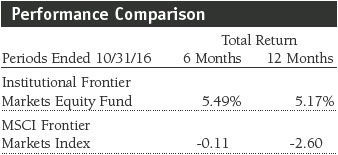
Your fund returned 5.49% in the second half of our fiscal year and 5.17% for the full year ended October 31, 2016. As shown in the Performance Comparison table, the fund significantly outperformed the MSCI Frontier Markets Index in both periods. Favorable stock selection, especially in Vietnam and, to a lesser extent, Sri Lanka, was the driving factor behind our outperformance in both periods.
Asia
Asian markets remain our favorites in the frontier universe, as they offer excellent mixes of economic growth, increasing consumption, and quality companies, many of which are trading at attractive valuations. Asia is our largest regional overweight versus the index, and we are emphasizing Vietnam, Sri Lanka, and Pakistan, in particular.
Vietnam has one of the healthiest macro backdrops in the frontier markets universe, with export-led growth, steady levels of foreign investment, and low inflation. Despite the broad stock market’s uninspiring returns, our stock selection in the country significantly lifted our performance relative to the benchmark. Two of our top contributors over the last year were Vietnam Dairy Products, the country’s dominant dairy, and drugmaker DHG Pharmaceutical. Both companies benefited from favorable economic and consumption trends. The general lifting of foreign ownership restrictions on Vietnamese companies is also a plus; in fact, in July, Japan’s Taisho Pharmaceutical bought a 24.5% stake in DHG. Two other strong contributors were Vingroup and Hoa Phat Group. The former is a real estate company that is benefiting from a young and growing population in demand of living space. The latter is Vietnam’s leading iron and steel manufacturer, whose tight cost controls are contributing to above-average growth as the company takes market share from competitors. We trimmed our positions in several of these companies on strength, as valuations are starting to become expensive. We also eliminated holding company Masan, whose mining business has been hurt by heavy financial expenses and scrutiny of its environmental standards. (Please refer to the fund’s portfolio of investments for a complete list of holdings and the amount each represents in the portfolio.)
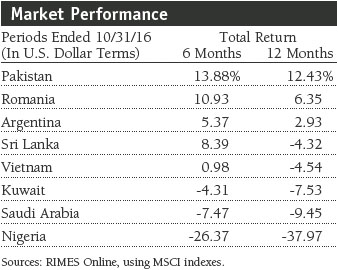
Banks remain important investments in the frontier universe, especially in Asia, as they enable us to harness the economic potential of various countries. Although our Vietnamese bank stocks, such as Bank for Foreign Trade of Vietnam, were lackluster over the last year, our positions in Pakistani banks United Bank and Habib Bank were solid contributors, especially in the second half of our fiscal year. These Pakistani banks are set to benefit from a pickup in credit growth in the midst of an improving economy. Shares were also lifted by the pending reclassification of Pakistan to emerging market status.
Unfortunately, not all of our Pakistani holdings did well. Our position in media company Hum Network fared poorly, for example. The company produces several TV channels and, in anticipation of competition, is starting a film production company and launching a streaming service. Shares of dairy business Nestle Pakistan also sagged, in part because investors favored other Pakistani names as possible additions to the MSCI Emerging Markets Index. However, the company is well managed, has an excellent track record, and offers a decent dividend.
Our top absolute contributor in the entire portfolio over the last year was Sri Lankan company Ceylon Cold Stores, the country’s number one maker of soft drinks and ice cream and operator of a fast-growing grocery store chain. The company recently reported brisk sales and solid growth in its fiscal second quarter, and we have trimmed our position on strength. Lion Brewery Ceylon was disappointing, however, while shares of Nestle Lanka were flat for the year. In the last six months, we reestablished a position in conglomerate John Keells Holdings because we see a compelling growth trajectory for its consumer foods and retail businesses as wages increase.

Middle East and Africa
Saudi Arabian stocks generally fell over the last year. The economy has been struggling amid lower oil prices, forcing the government to reduce spending by cutting public sector wages and bonuses and subsidies to various companies. Our Saudi exposure represents our largest country overweight versus the benchmark—in fact, the country is still not classified by MSCI. Hospital operator Al Mouwasat Medical Services produced good returns. The company recently reported strong third-quarter earnings, and we believe it is well positioned to benefit from the buildout of private hospitals in the kingdom. A new portfolio holding is Bupa Arabia for Cooperative Insurance, which is Saudi Arabia’s largest health insurer and has, in our opinion, a superior product offering and customer service platform. On the other hand, we eliminated Saudi Airlines Catering, as the lower oil price environment has caused a slower pace of fleet expansion at Saudi Arabian airlines and a worsening outlook for revenues.
In contrast to Saudi Arabia, our Kuwait allocation is our largest underweight versus the benchmark. We continue to have difficulty finding quality companies here. Our only holdings were conglomerate Kuwait Projects Company, which produced mild gains, and National Bank of Kuwait, the emirate’s largest bank, which was one of our largest detractors in absolute terms.
In sub-Saharan Africa, we have small positions in countries such as Uganda and Botswana, but most of our investments are in Kenya and Nigeria. In Kenya, economic growth remains robust and is not based on commodity production, but the country’s level of debt is climbing. In the last six months, we eliminated Equity Group Holdings and KCB (Kenya Commercial Bank), as the Kenyan president signed legislation that caps lending rates and sets a floor on deposit rates. We believe this will hurt banks’ profits and eventually slow economic growth. We purchased ARM Cement, which operates in Kenya and Tanzania, after the company was forced to seek an infusion of capital from the private-equity arm of the UK government. We maintained a large position in Safaricom, which was one of the fund’s top performers over the last year. This mobile phone service and money transfer service provider is used by almost the entire Kenyan adult population.
Nigerian stocks plunged, largely because of the steep devaluation of the naira in June. Pressure had been building on the currency due to factors such as a severe recession, low oil prices, a dollar shortage, and shortages of various goods. The devaluation was not a surprise to us—in fact, we were visiting the country right around the time of the devaluation—so we took advantage of the situation and added Guaranty Trust Bank to the portfolio at an undeniably attractive valuation. We also purchased low-cost cement producer Dangote Cement, which is aggressively expanding into several nearby countries. We maintained positions in Nestle Foods Nigeria, Nigerian Breweries, and SEPLAT Petroleum Development, all of which declined over the last year. While we are optimistic that a recovery will eventually take root, we expect the macro situation to remain uncertain for some time, as inflation is very high, the naira is not yet truly floating freely, and it will take some time for the effects of the devaluation to be fully felt throughout the economy.
Latin America
Argentina typifies our case for frontier markets investing. The reform efforts of President Mauricio Macri’s government and an improving macro backdrop have been supportive of well-positioned, high-quality Argentine businesses, and we are increasingly finding good bottom-up investment opportunities. At 17% of fund assets, Argentina is the only Latin American country listed in the portfolio of investments, and we are overweighting it versus the benchmark.
Grupo Financiero Galicia, a financial services holding company, was a top performer in our 6- and 12-month reporting periods. The company’s banking and consumer lending businesses should benefit over time from lower inflation, improving business sentiment, and increasing credit growth. Shares of Argentina’s number one cable operator, Grupo Clarin, also did well in both periods. The company’s earnings are good, but the stock trades at a very cheap valuation relative to other cable operators in the region, and we believe that discount will narrow over time. Energy giant YPF fared poorly, but Tenaris, a maker of pipes for the oil and gas industry, held up fairly well. Earnings are currently under pressure, but the company is well managed, and we believe that it will emerge from the oil-related downturn even stronger than it is now.
We continued to own shares of PriceSmart, a U.S.-based shopping warehouse company with business in several Latin American countries—especially Colombia, where it is attempting to make deeper inroads—and in the Caribbean. While shares were lackluster over the last year, we are maintaining a longer-term perspective, recognizing that it will take several years for PriceSmart’s warehouse clubs to realize their full potential.
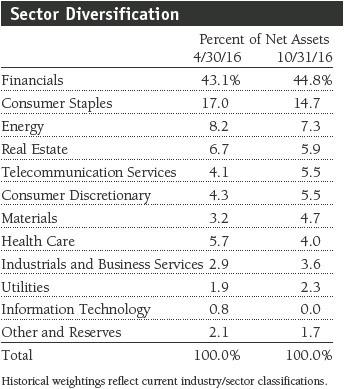
Emerging Europe
Our frontier markets exposure in this region is limited primarily to Romania and Georgia. In resource-rich Kazakhstan, we only own Halyk Savings Bank of Kazakhstan, which we added in the first half of our fiscal year when oil prices were bottoming. Our investment contributed significantly in the last six months, helped by the partial recovery of oil prices.
In Romania, strong economic growth is creating a favorable backdrop for banks. Banca Transilvania, which produced gains over the last year, is a quality, profitable bank with solid positioning in faster-growing segments and will benefit substantially from the improving macro environment. In the last six months, we established a position in BRD–Groupe Societe Generale. It has positive earnings momentum, has started to pay dividends again, and is trading at an attractive valuation.
Economic growth in Georgia is also strong. In fact, Georgia is becoming a financial hub in the region and could become a more significant transit hub in the years ahead. Our investment in Bgeo Group (formerly Bank of Georgia Holdings) produced reasonable returns over the last year. Georgia Healthcare, which we added in the first half of our fiscal year, made a substantial contribution to our performance in the last six months. The company recently acquired GPC, which is one of the largest pharmaceutical retailers in Georgia and which also operates a number of express ambulatory clinics. Not only was the deal inexpensive, it will also add to Georgia Healthcare’s earnings immediately. In addition, we believe it will enable the company to accelerate its opening of health care clinics that can feed into its hospital network.
Outlook
Frontier equity markets in general were lackluster over the last year, as high inflation, currency pressures, commodity price volatility, or other country-specific issues weighed on their performance. We are pleased with our research-driven relative performance over the last year and believe that there is enough encouraging news flow to remain positive on near- and longer-term prospects for frontier markets. While unexpected events like the UK’s vote to leave the European Union or Donald Trump’s victory in the U.S. presidential election often create periods of global financial market volatility, the low correlation of frontier markets to their counterparts in developed and emerging markets can provide some insulation from such risk-off events. Quite simply, most frontier markets have their own domestic drivers for growth.
In Asia, the growth prospects for our preferred frontier markets remain solid given favorable macro conditions and relatively low fiscal imbalances. With Pakistan graduating to the emerging markets universe next year—as Qatar and the United Arab Emirates did a couple of years ago—we are further convinced that other frontier markets have the potential to follow suit over time.
Vietnam could be affected in some way by the incoming Trump administration’s trade policies. If the U.S. government does not ratify the Trans-Pacific Partnership trade agreement or if the U.S. enacts policies that hurt global trade, it could reduce Vietnam’s long-term growth potential to some extent. On the other hand, if the U.S. just imposes tariffs on Chinese imports, Vietnam could be a net beneficiary.
Argentina’s rapid moves over the last year under President Macri to bring the country back into the global marketplace are very encouraging, as they have succeeded in attracting significant foreign direct investment. However, macro challenges remain, including a taming of inflation and the fiscal deficit, and we are hopeful that Macri’s efforts will continue to bear fruit ahead of next year’s midterm elections.
In the Middle East and Africa, oil-exporting economies have been challenged by the significant drop in oil prices over the last two years. As commodity prices stabilize, most of the countries have adapted to the “new normal,” and as we look forward, we have a more positive view of the region. Nigeria is facing significant challenges, but the currency is now at a more realistic level, and the equity market has not been this cheap for 10 years.
We continue to believe that frontier markets have a place in an investor’s global portfolio, albeit a small one due to the heightened risks of the asset class. Macro fundamentals and demographics in many frontier countries are favorable and, in some cases, resemble those of emerging countries about 15 to 20 years ago. Economic growth in the frontier universe generally remains superior to the sluggish growth of developed countries and the decelerating growth of emerging markets. Of course, conditions vary widely by country, and there will be individual winners and losers, even in the same country and region. Therefore, we believe our rigorous research efforts are key to harnessing the long-term potential of investing in frontier equity markets.
Thank you for your confidence in our investment management capabilities.
Respectfully submitted,

Oliver Bell
Portfolio manager
November 18, 2016
The portfolio manager has day-to-day responsibility for managing the portfolio and works with committee members in developing and executing the fund’s investment program.
| Risks of International Investing |
Funds that invest overseas generally carry more risk than funds that invest strictly in U.S. assets. Funds investing in a single country, a limited geographic region, or emerging markets tend to be riskier than more diversified funds. Risks can result from varying stages of economic and political development; differing regulatory environments, trading days, and accounting standards; and higher transaction costs of non-U.S. markets. Non-U.S. investments are also subject to currency risk, or a decline in the value of a foreign currency versus the U.S. dollar, which reduces the dollar value of securities denominated in that currency.
The risks of international investing are heightened for investments in emerging markets and frontier markets countries. Emerging and frontier markets countries tend to have economic structures that are less diverse and less mature and political systems that are less stable than those of developed market countries. In addition to all of the risks of investing in international developed markets, emerging and frontier markets tend to have less liquid and less efficient trading markets and are more susceptible to governmental interference, local taxes being imposed on international investments, and restrictions on gaining access to sales proceeds.
Frontier markets generally have smaller economies or less mature capital markets than emerging markets, and as a result, the risks typically associated with investing in emerging market countries are magnified in frontier countries. Adverse changes in currency values of frontier markets countries may be severe, and settlement procedures and custody services may prove inadequate in certain markets. The markets of frontier countries typically have low trading volumes and the potential for extreme price volatility and illiquidity. This volatility may be further increased by the actions of a few major investors.
MSCI Frontier Markets Index: An index that measures the performance of stocks in various frontier markets countries.
Note: MSCI makes no express or implied warranties or representations and shall have no liability whatsoever with respect to any MSCI data contained herein. The MSCI data may not be further redistributed or used as a basis for other indices or any securities or financial products. This report is not approved, reviewed, or produced by MSCI.
Portfolio Highlights
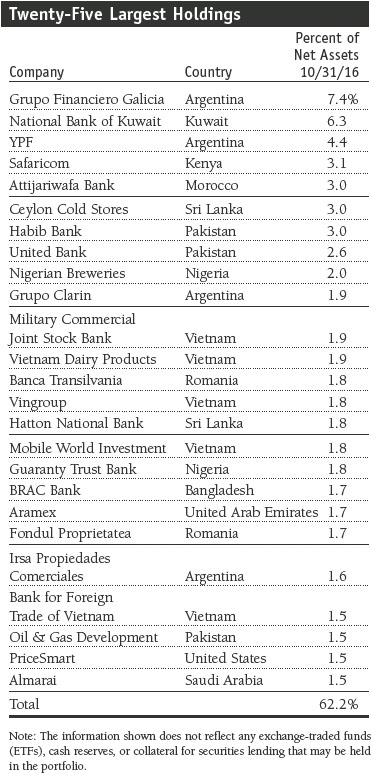
Performance and Expenses
T. Rowe Price Institutional Frontier Markets Equity Fund
This chart shows the value of a hypothetical $1 million investment in the fund over the past 10 fiscal year periods or since inception (for funds lacking 10-year records). The result is compared with benchmarks, which may include a broad-based market index and a peer group average or index. Market indexes do not include expenses, which are deducted from fund returns as well as mutual fund averages and indexes.
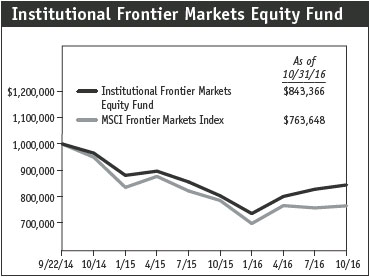
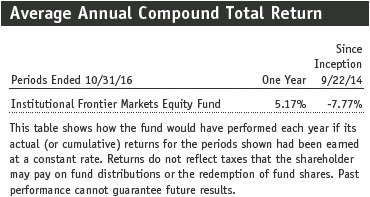
Fund Expense Example
As a mutual fund shareholder, you may incur two types of costs: (1) transaction costs, such as redemption fees or sales loads, and (2) ongoing costs, including management fees, distribution and service (12b-1) fees, and other fund expenses. The following example is intended to help you understand your ongoing costs (in dollars) of investing in the fund and to compare these costs with the ongoing costs of investing in other mutual funds. The example is based on an investment of $1,000 invested at the beginning of the most recent six-month period and held for the entire period.
Actual Expenses
The first line of the following table (Actual) provides information about actual account values and actual expenses. You may use the information on this line, together with your account balance, to estimate the expenses that you paid over the period. Simply divide your account value by $1,000 (for example, an $8,600 account value divided by $1,000 = 8.6), then multiply the result by the number on the first line under the heading “Expenses Paid During Period” to estimate the expenses you paid on your account during this period.
Hypothetical Example for Comparison Purposes
The information on the second line of the table (Hypothetical) is based on hypothetical account values and expenses derived from the fund’s actual expense ratio and an assumed 5% per year rate of return before expenses (not the fund’s actual return). You may compare the ongoing costs of investing in the fund with other funds by contrasting this 5% hypothetical example and the 5% hypothetical examples that appear in the shareholder reports of the other funds. The hypothetical account values and expenses may not be used to estimate the actual ending account balance or expenses you paid for the period.
You should also be aware that the expenses shown in the table highlight only your ongoing costs and do not reflect any transaction costs, such as redemption fees or sales loads. Therefore, the second line of the table is useful in comparing ongoing costs only and will not help you determine the relative total costs of owning different funds. To the extent a fund charges transaction costs, however, the total cost of owning that fund is higher.
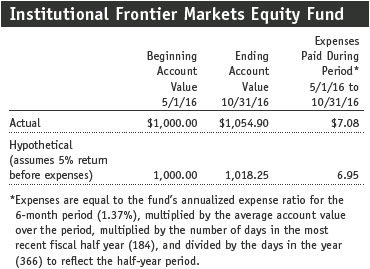
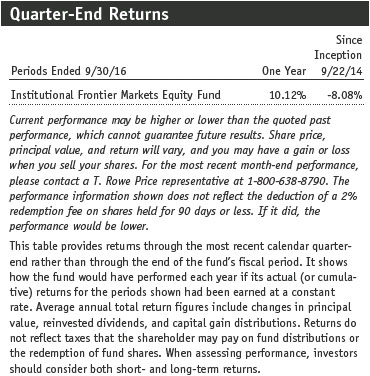

Financial Highlights
T. Rowe Price Institutional Frontier Markets Equity Fund
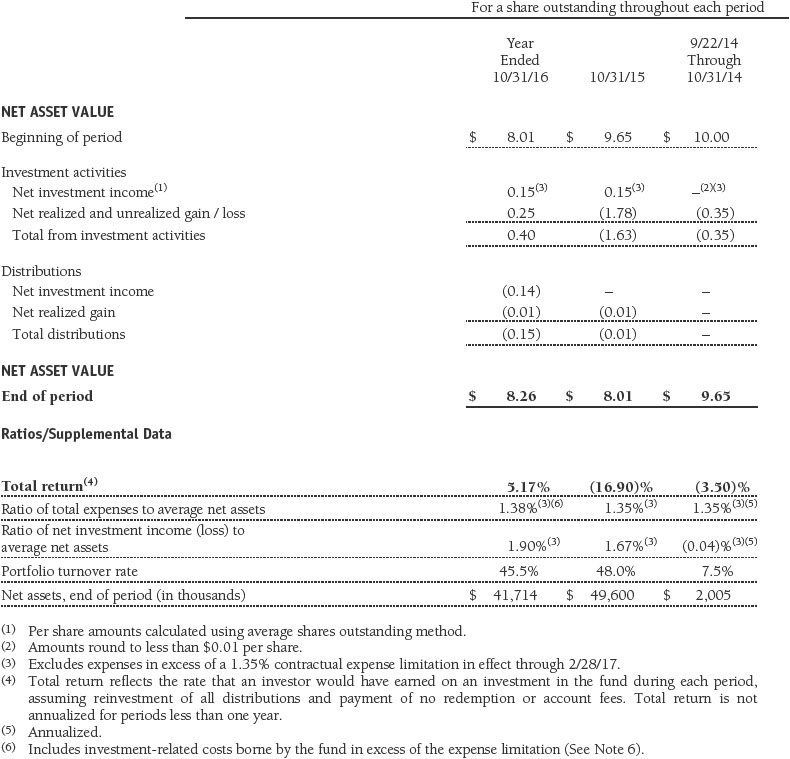
The accompanying notes are an integral part of these financial statements.
Portfolio of Investments‡
T. Rowe Price Institutional Frontier Markets Equity Fund
October 31, 2016
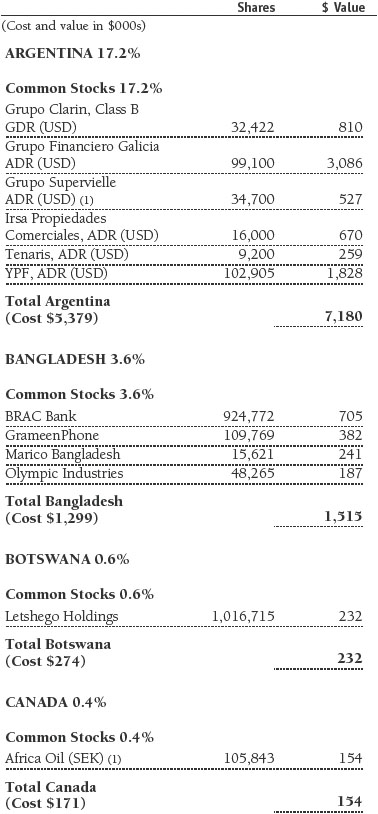
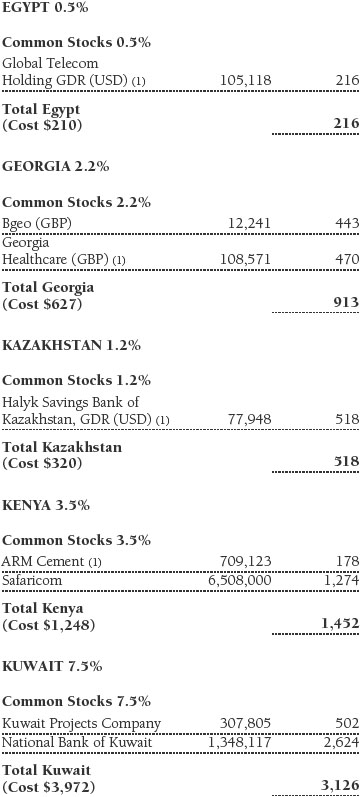

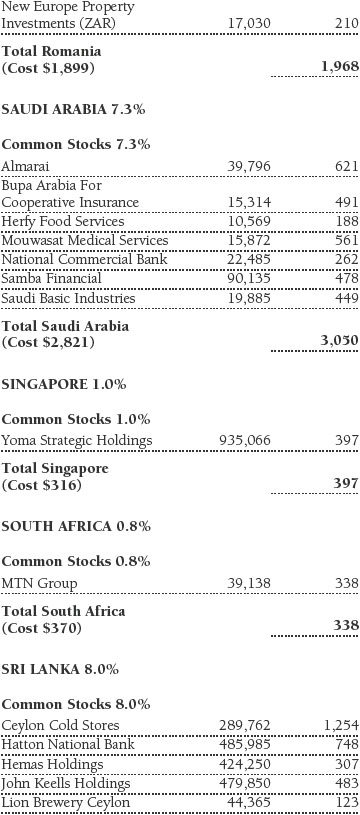
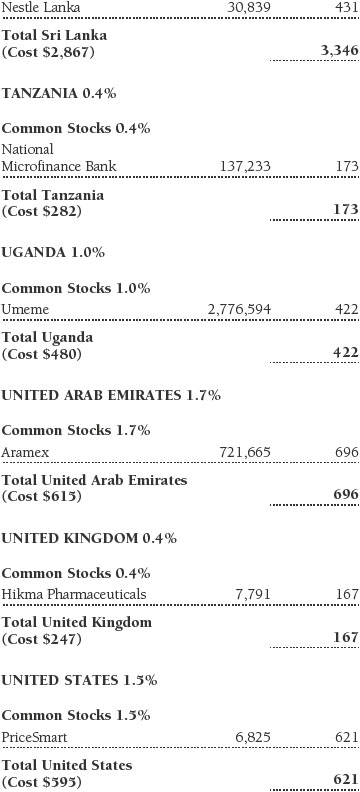


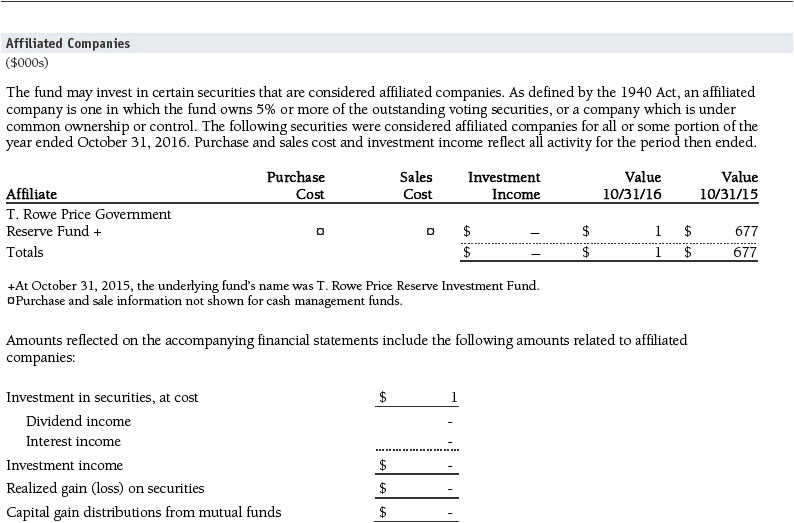
The accompanying notes are an integral part of these financial statements.
Statement of Assets and Liabilities
T. Rowe Price Institutional Frontier Markets Equity Fund
October 31, 2016
($000s, except shares and per share amounts)
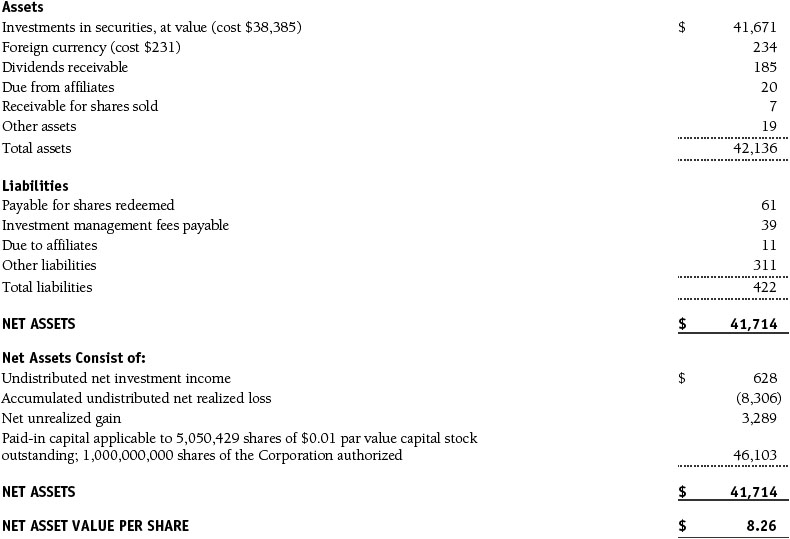
The accompanying notes are an integral part of these financial statements.
Statement of Operations
T. Rowe Price Institutional Frontier Markets Equity Fund
($000s)
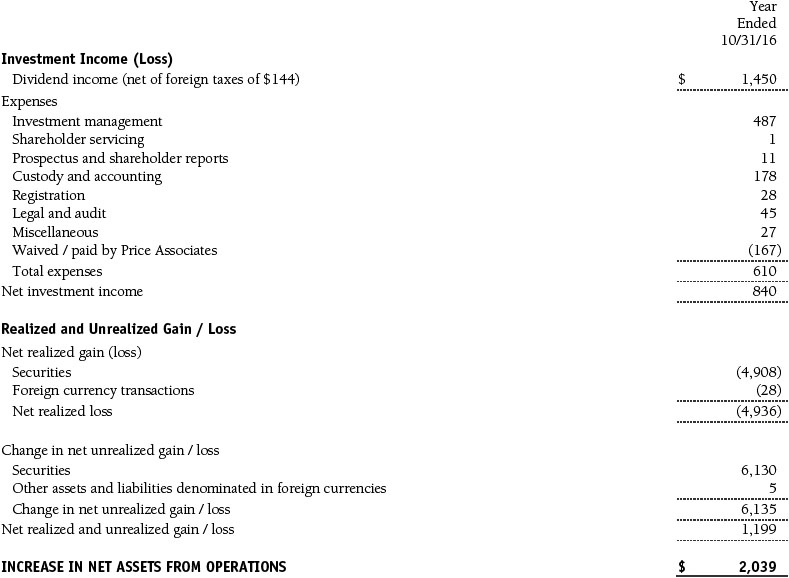
The accompanying notes are an integral part of these financial statements.
Statement of Changes in Net Assets
T. Rowe Price Institutional Frontier Markets Equity Fund
($000s)

The accompanying notes are an integral part of these financial statements.
Notes to Financial Statements
T. Rowe Price Institutional Frontier Markets Equity Fund
October 31, 2016
T. Rowe Price Institutional International Funds, Inc. (the corporation), is registered under the Investment Company Act of 1940 (the 1940 Act). The Institutional Frontier Markets Equity Fund (the fund) is a nondiversified, open-end management investment company established by the corporation. The fund seeks long-term growth of capital.
NOTE 1 - SIGNIFICANT ACCOUNTING POLICIES
Basis of Preparation The fund is an investment company and follows accounting and reporting guidance in the Financial Accounting Standards Board (FASB) Accounting Standards Codification Topic 946 (ASC 946). The accompanying financial statements were prepared in accordance with accounting principles generally accepted in the United States of America (GAAP), including, but not limited to, ASC 946. GAAP requires the use of estimates made by management. Management believes that estimates and valuations are appropriate; however, actual results may differ from those estimates, and the valuations reflected in the accompanying financial statements may differ from the value ultimately realized upon sale or maturity.
Investment Transactions, Investment Income, and Distributions Income and expenses are recorded on the accrual basis. Dividends received from mutual fund investments are reflected as dividend income; capital gain distributions are reflected as realized gain/loss. Dividend income and capital gain distributions are recorded on the ex-dividend date. Income tax-related interest and penalties, if incurred, would be recorded as income tax expense. Investment transactions are accounted for on the trade date. Realized gains and losses are reported on the identified cost basis. Income distributions are declared and paid annually. Distributions to shareholders are recorded on the ex-dividend date. Capital gain distributions are generally declared and paid by the fund annually.
Currency Translation Assets, including investments, and liabilities denominated in foreign currencies are translated into U.S. dollar values each day at the prevailing exchange rate, using the mean of the bid and asked prices of such currencies against U.S. dollars as quoted by a major bank. Purchases and sales of securities, income, and expenses are translated into U.S. dollars at the prevailing exchange rate on the date of the transaction. The effect of changes in foreign currency exchange rates on realized and unrealized security gains and losses is reflected as a component of security gains and losses.
Redemption Fees A 2% fee is assessed on redemptions of fund shares held for 90 days or less to deter short-term trading and to protect the interests of long-term shareholders. Redemption fees are withheld from proceeds that shareholders receive from the sale or exchange of fund shares. The fees are paid to the fund and are recorded as an increase to paid-in capital. The fees may cause the redemption price per share to differ from the net asset value per share.
New Accounting Guidance In October 2016, the Securities and Exchange Commission (SEC) issued a new rule, Investment Company Reporting Modernization, which, among other provisions, amends Regulation S-X to require standardized, enhanced disclosures, particularly related to derivatives, in investment company financial statements. Compliance with the guidance is required for financial statements filed with the SEC on or after August 1, 2017; adoption will have no effect on the fund’s net assets or results of operations.
NOTE 2 - VALUATION
The fund’s financial instruments are valued and its net asset value (NAV) per share is computed at the close of the New York Stock Exchange (NYSE), normally 4 p.m. ET, each day the NYSE is open for business. However, the NAV per share may be calculated at a time other than the normal close of the NYSE if trading on the NYSE is restricted, if the NYSE closes earlier, or as may be permitted by the SEC.
Fair Value The fund’s financial instruments are reported at fair value, which GAAP defines as the price that would be received to sell an asset or paid to transfer a liability in an orderly transaction between market participants at the measurement date. The T. Rowe Price Valuation Committee (the Valuation Committee) is an internal committee that has been delegated certain responsibilities by the fund’s Board of Directors (the Board) to ensure that financial instruments are appropriately priced at fair value in accordance with GAAP and the 1940 Act. Subject to oversight by the Board, the Valuation Committee develops and oversees pricing-related policies and procedures and approves all fair value determinations. Specifically, the Valuation Committee establishes procedures to value securities; determines pricing techniques, sources, and persons eligible to effect fair value pricing actions; oversees the selection, services, and performance of pricing vendors; oversees valuation-related business continuity practices; and provides guidance on internal controls and valuation-related matters. The Valuation Committee reports to the Board and has representation from legal, portfolio management and trading, operations, risk management, and the fund’s treasurer.
Various valuation techniques and inputs are used to determine the fair value of financial instruments. GAAP establishes the following fair value hierarchy that categorizes the inputs used to measure fair value:
Level 1 – quoted prices (unadjusted) in active markets for identical financial instruments that the fund can access at the reporting date
Level 2 – inputs other than Level 1 quoted prices that are observable, either directly or indirectly (including, but not limited to, quoted prices for similar financial instruments in active markets, quoted prices for identical or similar financial instruments in inactive markets, interest rates and yield curves, implied volatilities, and credit spreads)
Level 3 – unobservable inputs
Observable inputs are developed using market data, such as publicly available information about actual events or transactions, and reflect the assumptions that market participants would use to price the financial instrument. Unobservable inputs are those for which market data are not available and are developed using the best information available about the assumptions that market participants would use to price the financial instrument. GAAP requires valuation techniques to maximize the use of relevant observable inputs and minimize the use of unobservable inputs. When multiple inputs are used to derive fair value, the financial instrument is assigned to the level within the fair value hierarchy based on the lowest-level input that is significant to the fair value of the financial instrument. Input levels are not necessarily an indication of the risk or liquidity associated with financial instruments at that level but rather the degree of judgment used in determining those values.
Valuation Techniques Equity securities listed or regularly traded on a securities exchange or in the over-the-counter (OTC) market are valued at the last quoted sale price or, for certain markets, the official closing price at the time the valuations are made. OTC Bulletin Board securities are valued at the mean of the closing bid and asked prices. A security that is listed or traded on more than one exchange is valued at the quotation on the exchange determined to be the primary market for such security. Listed securities not traded on a particular day are valued at the mean of the closing bid and asked prices for domestic securities and the last quoted sale or closing price for international securities.
For valuation purposes, the last quoted prices of non-U.S. equity securities may be adjusted to reflect the fair value of such securities at the close of the NYSE. If the fund determines that developments between the close of a foreign market and the close of the NYSE will, in its judgment, materially affect the value of some or all of its portfolio securities, the fund will adjust the previous quoted prices to reflect what it believes to be the fair value of the securities as of the close of the NYSE. In deciding whether it is necessary to adjust quoted prices to reflect fair value, the fund reviews a variety of factors, including developments in foreign markets, the performance of U.S. securities markets, and the performance of instruments trading in U.S. markets that represent foreign securities and baskets of foreign securities. The fund may also fair value securities in other situations, such as when a particular foreign market is closed but the fund is open. The fund uses outside pricing services to provide it with quoted prices and information to evaluate or adjust those prices. The fund cannot predict how often it will use quoted prices and how often it will determine it necessary to adjust those prices to reflect fair value. As a means of evaluating its security valuation process, the fund routinely compares quoted prices, the next day’s opening prices in the same markets, and adjusted prices.
Actively traded equity securities listed on a domestic exchange generally are categorized in Level 1 of the fair value hierarchy. Non-U.S. equity securities generally are categorized in Level 2 of the fair value hierarchy despite the availability of quoted prices because, as described above, the fund evaluates and determines whether those quoted prices reflect fair value at the close of the NYSE or require adjustment. OTC Bulletin Board securities, certain preferred securities, and equity securities traded in inactive markets generally are categorized in Level 2 of the fair value hierarchy.
Investments in mutual funds are valued at the mutual fund’s closing NAV per share on the day of valuation and are categorized in Level 1 of the fair value hierarchy. Assets and liabilities other than financial instruments, including short-term receivables and payables, are carried at cost, or estimated realizable value, if less, which approximates fair value.
Thinly traded financial instruments and those for which the above valuation procedures are inappropriate or are deemed not to reflect fair value are stated at fair value as determined in good faith by the Valuation Committee. The objective of any fair value pricing determination is to arrive at a price that could reasonably be expected from a current sale. Financial instruments fair valued by the Valuation Committee are primarily private placements, restricted securities, warrants, rights, and other securities that are not publicly traded.
Subject to oversight by the Board, the Valuation Committee regularly makes good faith judgments to establish and adjust the fair valuations of certain securities as events occur and circumstances warrant. For instance, in determining the fair value of an equity investment with limited market activity, such as a private placement or a thinly traded public company stock, the Valuation Committee considers a variety of factors, which may include, but are not limited to, the issuer’s business prospects, its financial standing and performance, recent investment transactions in the issuer, new rounds of financing, negotiated transactions of significant size between other investors in the company, relevant market valuations of peer companies, strategic events affecting the company, market liquidity for the issuer, and general economic conditions and events. In consultation with the investment and pricing teams, the Valuation Committee will determine an appropriate valuation technique based on available information, which may include both observable and unobservable inputs. The Valuation Committee typically will afford greatest weight to actual prices in arm’s length transactions, to the extent they represent orderly transactions between market participants, transaction information can be reliably obtained, and prices are deemed representative of fair value. However, the Valuation Committee may also consider other valuation methods such as market-based valuation multiples; a discount or premium from market value of a similar, freely traded security of the same issuer; or some combination. Fair value determinations are reviewed on a regular basis and updated as information becomes available, including actual purchase and sale transactions of the issue. Because any fair value determination involves a significant amount of judgment, there is a degree of subjectivity inherent in such pricing decisions, and fair value prices determined by the Valuation Committee could differ from those of other market participants. Depending on the relative significance of unobservable inputs, including the valuation technique(s) used, fair valued securities may be categorized in Level 2 or 3 of the fair value hierarchy.
Valuation Inputs The following table summarizes the fund’s financial instruments, based on the inputs used to determine their fair values on October 31, 2016:

There were no material transfers between Levels 1 and 2 during the year ended October 31, 2016.
NOTE 3 - OTHER INVESTMENT TRANSACTIONS
Consistent with its investment objective, the fund engages in the following practices to manage exposure to certain risks and/or to enhance performance. The investment objective, policies, program, and risk factors of the fund are described more fully in the fund’s prospectus and Statement of Additional Information.
Emerging and Frontier Markets The fund may invest, either directly or through investments in T. Rowe Price institutional funds, in securities of companies located in, issued by governments of, or denominated in or linked to the currencies of emerging and frontier market countries; at period-end, approximately 90% of the fund’s net assets were invested in frontier markets and 7% in emerging markets. Emerging markets and to a greater extent frontier markets, generally have economic structures that are less diverse and mature, and political systems that are less stable, than developed countries. These markets may be subject to greater political, economic, and social uncertainty and differing regulatory environments that may potentially impact the fund’s ability to buy or sell certain securities or repatriate proceeds to U.S. dollars. Such securities are often subject to greater price volatility, less liquidity, and higher rates of inflation than U.S. securities. Investing in frontier markets is significantly riskier than investing in other countries, including emerging markets.
Participation Notes The fund may invest in participation notes, through which a counterparty provides exposure to common stock, in the form of an unsecured interest, in markets where direct investment by the fund is not possible or preferable. Participation notes provide the economic benefit of common stock ownership to the fund, while legal ownership and voting rights are retained by the counterparty. Although participation notes are usually structured with a defined maturity or termination date, early redemption may be possible. Risks associated with participation notes include the possible failure of a counterparty to perform in accordance with the terms of the agreement, inability to transfer or liquidate the notes, potential delays or an inability to redeem before maturity under certain market conditions, and no legal recourse against the issuer of the underlying common stock.
Other Purchases and sales of portfolio securities other than short-term securities aggregated $20,073,000 and $29,291,000, respectively, for the year ended October 31, 2016.
NOTE 4 - FEDERAL INCOME TAXES
No provision for federal income taxes is required since the fund intends to continue to qualify as a regulated investment company under Subchapter M of the Internal Revenue Code and distribute to shareholders all of its taxable income and gains. Distributions determined in accordance with federal income tax regulations may differ in amount or character from net investment income and realized gains for financial reporting purposes. Financial reporting records are adjusted for permanent book/tax differences to reflect tax character but are not adjusted for temporary differences.
The fund files U.S. federal, state, and local tax returns as required. The fund’s tax returns are subject to examination by the relevant tax authorities until expiration of the applicable statute of limitations, which is generally three years after the filing of the tax return but which can be extended to six years in certain circumstances. Tax returns for open years have incorporated no uncertain tax positions that require a provision for income taxes.
Reclassifications between income and gain relate primarily to the character of net currency losses and the character of income on passive foreign investment companies. For the year ended October 31, 2016, the following reclassifications were recorded to reflect tax character (there was no impact on results of operations or net assets):

Distributions during the years ended October 31, 2016 and October 31, 2015, totaled $906,000 and $16,000, respectively, and were characterized as ordinary income for tax purposes. At October 31, 2016, the tax-basis cost of investments and components of net assets were as follows:

The difference between book-basis and tax-basis net unrealized appreciation (depreciation) is attributable to the deferral of losses from wash sales and the realization of gains/losses on passive foreign investment companies for tax purposes. The fund intends to retain realized gains to the extent of available capital loss carryforwards. Net realized capital losses may be carried forward indefinitely to offset future realized capital gains.
NOTE 5 - FOREIGN TAXES
The fund is subject to foreign income taxes imposed by certain countries in which it invests. Additionally, certain foreign currency transactions are subject to tax, and capital gains realized upon disposition of securities issued in or by certain foreign countries are subject to capital gains tax imposed by those countries. All taxes are computed in accordance with the applicable foreign tax law, and, to the extent permitted, capital losses are used to offset capital gains. Taxes attributable to income are accrued by the fund as a reduction of income. Taxes incurred on the purchase of foreign currencies are recorded as realized loss on foreign currency transactions. Current and deferred tax expense attributable to capital gains is reflected as a component of realized or change in unrealized gain/loss on securities in the accompanying financial statements. At October 31, 2016, the fund had no deferred tax liability attributable to foreign securities and no foreign capital loss carryforwards.
NOTE 6 - RELATED PARTY TRANSACTIONS
The fund is managed by T. Rowe Price Associates, Inc. (Price Associates), a wholly owned subsidiary of T. Rowe Price Group, Inc. (Price Group). Price Associates has entered into a sub-advisory agreement(s) with one or more of its wholly owned subsidiaries, to provide investment advisory services to the fund. The investment management agreement between the fund and Price Associates provides for an annual investment management fee equal to 1.10% of the fund’s average daily net assets. The fee is computed daily and paid monthly.
The fund is also subject to a contractual expense limitation through February 28, 2017. During the limitation period, Price Associates is required to waive its management fee and pay the fund for any expenses, excluding interest, taxes, brokerage commissions, and other non-recurring expenses permitted by the investment management agreement, that would otherwise cause the fund’s ratio of annualized total expenses to average net assets (expense ratio) to exceed its expense limitation of 1.35%. The fund is required to repay Price Associates for expenses previously waived/paid to the extent its net assets grow or expenses decline sufficiently to allow repayment without causing the fund’s expense ratio to exceed its expense limitation in effect at the time of the waiver. However, no repayment will be made more than three years after the date of a payment or waiver. Pursuant to this agreement, $167,000 of expenses were waived/paid by Price Associates during the year ended October 31, 2016 and remain subject to repayment by the fund. Including these amounts, expenses previously waived/paid by Price Associates in the amount of $415,000 remain subject to repayment by the fund at October 31, 2016.
In addition, the fund has entered into service agreements with Price Associates and a wholly owned subsidiary of Price Associates (collectively, Price). Price Associates provides certain accounting and administrative services to the fund. T. Rowe Price Services, Inc., provides shareholder and administrative services in its capacity as the fund’s transfer and dividend-disbursing agent. For the year ended October 31, 2016, expenses incurred pursuant to these service agreements were $60,000 for Price Associates and $1,000 for T. Rowe Price Services, Inc. The total amount payable at period-end pursuant to these service agreements is reflected as Due to Affiliates in the accompanying financial statements.
The fund may invest in the T. Rowe Price Government Reserve Fund, the T. Rowe Price Treasury Reserve Fund, or the T. Rowe Price Short-Term Fund (collectively, the Price Reserve Investment Funds), open-end management investment companies managed by Price Associates and considered affiliates of the fund. The Price Reserve Investment Funds are offered as short-term investment options to mutual funds, trusts, and other accounts managed by Price Associates or its affiliates and are not available for direct purchase by members of the public. The Price Reserve Investment Funds pay no investment management fees.
As of October 31, 2016, T. Rowe Price Group, Inc., or its wholly owned subsidiaries owned 2,520,186 shares of the fund, representing 50% of the fund’s net assets.
The fund may participate in securities purchase and sale transactions with other funds or accounts advised by Price Associates (cross trades), in accordance with procedures adopted by the fund’s Board and Securities and Exchange Commission rules, which require, among other things, that such purchase and sale cross trades be effected at the independent current market price of the security. During the year ended October 31, 2016, the fund had no purchases or sales cross trades with other funds or accounts advised by Price Associates.
Report of Independent Registered Public Accounting Firm
To the Board of Directors of T. Rowe Price Institutional International Funds, Inc. and
Shareholders of T. Rowe Price Institutional Frontier Markets Equity Fund
In our opinion, the accompanying statement of assets and liabilities, including the portfolio of investments, and the related statements of operations and of changes in net assets and the financial highlights present fairly, in all material respects, the financial position of the T. Rowe Price Institutional Frontier Markets Equity Fund (one of the portfolios comprising T. Rowe Price Institutional International Funds, Inc., hereafter referred to as the “Fund”) at October 31, 2016, the results of its operations, the changes in its net assets and the financial highlights for each of the periods indicated therein, in conformity with accounting principles generally accepted in the United States of America. These financial statements and financial highlights (hereafter referred to as “financial statements”) are the responsibility of the Fund’s management. Our responsibility is to express an opinion on these financial statements based on our audits. We conducted our audits of these financial statements in accordance with the standards of the Public Company Accounting Oversight Board (United States). Those standards require that we plan and perform the audit to obtain reasonable assurance about whether the financial statements are free of material misstatement. An audit includes examining, on a test basis, evidence supporting the amounts and disclosures in the financial statements, assessing the accounting principles used and significant estimates made by management, and evaluating the overall financial statement presentation. We believe that our audits, which included confirmation of securities at October 31, 2016 by correspondence with the custodian, and confirmation of the underlying fund by correspondence with the transfer agent, provide a reasonable basis for our opinion.
PricewaterhouseCoopers LLP
Baltimore, Maryland
December 15, 2016
| Tax Information (Unaudited) for the Tax Year Ended 10/31/16 |
We are providing this information as required by the Internal Revenue Code. The amounts shown may differ from those elsewhere in this report because of differences between tax and financial reporting requirements.
The fund’s distributions to shareholders included $60,000 from short-term capital gains.
For taxable non-corporate shareholders, $456,000 of the fund’s income represents qualified dividend income subject to a long-term capital gains tax rate of not greater than 20%.
For corporate shareholders, $5,000 of the fund’s income qualifies for the dividends-received deduction.
The fund will pass through foreign source income of $922,000 and foreign taxes paid of $156,000.
| Information on Proxy Voting Policies, Procedures, and Records |
A description of the policies and procedures used by T. Rowe Price funds and portfolios to determine how to vote proxies relating to portfolio securities is available in each fund’s Statement of Additional Information. You may request this document by calling 1-800-225-5132 or by accessing the SEC’s website, sec.gov.
The description of our proxy voting policies and procedures is also available on our corporate website. To access it, please visit the following Web page:
https://www3.troweprice.com/usis/corporate/en/utility/policies.html
Scroll down to the section near the bottom of the page that says, “Proxy Voting Policies.” Click on the Proxy Voting Policies link in the shaded box.
Each fund’s most recent annual proxy voting record is available on our website and through the SEC’s website. To access it through T. Rowe Price, visit the website location shown above, and scroll down to the section near the bottom of the page that says, “Proxy Voting Records.” Click on the Proxy Voting Records link in the shaded box.
| How to Obtain Quarterly Portfolio Holdings |
The fund files a complete schedule of portfolio holdings with the Securities and Exchange Commission for the first and third quarters of each fiscal year on Form N-Q. The fund’s Form N-Q is available electronically on the SEC’s website (sec.gov); hard copies may be reviewed and copied at the SEC’s Public Reference Room, 100 F St. N.E., Washington, DC 20549. For more information on the Public Reference Room, call 1-800-SEC-0330.
| About the Fund’s Directors and Officers |
Your fund is overseen by a Board of Directors (Board) that meets regularly to review a wide variety of matters affecting or potentially affecting the fund, including performance, investment programs, compliance matters, advisory fees and expenses, service providers, and business and regulatory affairs. The Board elects the fund’s officers, who are listed in the final table. At least 75% of the Board’s members are independent of T. Rowe Price Associates, Inc. (T. Rowe Price), and its affiliates; “inside” or “interested” directors are employees or officers of T. Rowe Price. The business address of each director and officer is 100 East Pratt Street, Baltimore, Maryland 21202. The Statement of Additional Information includes additional information about the fund directors and is available without charge by calling a T. Rowe Price representative at 1-800-638-5660.
Independent Directors
Name (Year of Birth)
Year Elected* [Number of
T. Rowe Price Portfolios
Overseen] | | Principal Occupation(s) and Directorships of Public Companies and Other Investment Companies During the Past Five Years |
| | |
William R. Brody, M.D., Ph.D. (1944)
2009 [186] | | President and Trustee, Salk Institute for Biological Studies (2009 to present); Director, BioMed Realty Trust (2013 to 2016); Chairman of the Board, Mesa Biotech, a molecular diagnostic company (March 2016 to present); Director, Radiology Partners, an integrated radiology practice management company (June 2016 to present); Director, Novartis, Inc. (2009 to 2014); Director, IBM (2007 to present) |
| | |
Anthony W. Deering (1945)
1991 [186] | | Chairman, Exeter Capital, LLC, a private investment firm (2004 to present); Director, Brixmor Real Estate Investment Trust (2012 to present); Director and Advisory Board Member, Deutsche Bank North America (2004 to present); Director, Under Armour (2008 to present); Director, Vornado Real Estate Investment Trust (2004 to 2012) |
| | |
Bruce W. Duncan (1951)
2013 [186] | | Chief Executive Officer and Director (2009 to present), Chairman of the Board (January 2016 to present), and President (2009 to September 2016), First Industrial Realty Trust, an owner and operator of industrial properties; Chairman of the Board (2005 to May 2016) and Director (1999 to May 2016), Starwood Hotels & Resorts, a hotel and leisure company; Director, Boston Properties (May 2016 to present) |
| | |
Robert J. Gerrard, Jr. (1952)
2012 [186] | | Advisory Board Member, Pipeline Crisis/Winning Strategies, a collaborative working to improve opportunities for young African Americans (1997 to present) |
| | | |
Paul F. McBride (1956)
2013 [186] | | Advisory Board Member, Vizzia Technologies (2015 to present) |
| | | |
Cecilia E. Rouse, Ph.D. (1963)
2012 [186] | | Dean, Woodrow Wilson School (2012 to present); Professor and Researcher, Princeton University (1992 to present); Director, MDRC, a nonprofit education and social policy research organization (2011 to present); Member of National Academy of Education (2010 to present); Research Associate of Labor Program (2011 to present) and Board Member (2015 to present), National Bureau of Economic Research (2011 to present); Chair of Committee on the Status of Minority Groups in the Economic Profession (2012 to present) and Vice President (2015 to present), American Economic Association |
| | | |
John G. Schreiber (1946)
2001 [186] | | Owner/President, Centaur Capital Partners, Inc., a real estate investment company (1991 to present); Cofounder, Partner, and Cochairman of the Investment Committee, Blackstone Real Estate Advisors, L.P. (1992 to 2015); Director, General Growth Properties, Inc. (2010 to 2013); Director, Blackstone Mortgage Trust, a real estate financial company (2012 to 2016); Director and Chairman of the Board, Brixmor Property Group, Inc. (2013 to present); Director, Hilton Worldwide (2013 to present); Director, Hudson Pacific Properties (2014 to 2016) |
| | |
Mark R. Tercek (1957)
2009 [186] | | President and Chief Executive Officer, The Nature Conservancy (2008 to present) |
| |
| *Each independent director serves until retirement, resignation, or election of a successor. |
Inside Directors
Name (Year of Birth)
Year Elected* [Number of
T. Rowe Price Portfolios
Overseen] | | Principal Occupation(s) and Directorships of Public Companies and Other Investment Companies During the Past Five Years |
| | |
Edward C. Bernard (1956)
2006 [186] | | Director and Vice President, T. Rowe Price; Vice Chairman of the Board, Director, and Vice President, T. Rowe Price Group, Inc.; Chairman of the Board, Director, and President, T. Rowe Price Investment Services, Inc.; Chairman of the Board and Director, T. Rowe Price Retirement Plan Services, Inc., and T. Rowe Price Services, Inc.; Chairman of the Board, Chief Executive Officer, Director, and President, T. Rowe Price International and T. Rowe Price Trust Company; Chairman of the Board, all funds |
| | | |
Brian C. Rogers, CFA, CIC (1955)
2006 [131] | | Chief Investment Officer, Director, and Vice President, T. Rowe Price; Chairman of the Board, Chief Investment Officer, Director, and Vice President, T. Rowe Price Group, Inc.; Vice President, T. Rowe Price Trust Company |
| |
| *Each inside director serves until retirement, resignation, or election of a successor. |
Officers
Name (Year of Birth)
Position Held With Institutional International Funds | | Principal Occupation(s) |
| | | |
Ulle Adamson, CFA (1979)
Vice President | | Vice President, T. Rowe Price Group, Inc., and T. Rowe Price International |
| | |
Roy H. Adkins (1970)
Vice President | | Vice President, T. Rowe Price Group, Inc., and T. Rowe Price International |
| | |
Christopher D. Alderson (1962)
President | | Company’s Representative and Vice President, Price Hong Kong; Vice President, Price Singapore; Director and Vice President, T. Rowe Price International; Vice President, T. Rowe Price Group, Inc. |
| | |
Paulina Amieva (1981)
Vice President | | Vice President, T. Rowe Price and T. Rowe Price Group, Inc. |
| | |
Malik S. Asif (1981)
Vice President | | Vice President, T. Rowe Price Group, Inc., and T. Rowe Price International; formerly, student, The University of Chicago Booth School of Business (to 2012) |
| | |
Harishankar Balkrishna (1983)
Vice President | | Vice President, T. Rowe Price Group, Inc., and T. Rowe Price International |
| | |
Sheena L. Barbosa (1983)
Vice President | | Vice President, Price Hong Kong and T. Rowe Price Group, Inc. |
| | |
Peter J. Bates, CFA (1974)
Vice President | | Vice President, T. Rowe Price and T. Rowe Price Group, Inc. |
| | |
Oliver D.M. Bell, IMC (1969)
Executive Vice President | | Vice President, T. Rowe Price Group, Inc., and T. Rowe Price International |
| | |
R. Scott Berg, CFA (1972)
Executive Vice President | | Vice President, T. Rowe Price and T. Rowe Price Group, Inc. |
| | |
Steven E. Boothe, CFA (1977)
Vice President | | Vice President, T. Rowe Price and T. Rowe Price Group, Inc. |
| | |
Peter I. Botoucharov (1965)
Vice President | | Vice President, T. Rowe Price Group, Inc., and T. Rowe Price International; formerly, Director, EMEA Macroeconomic Research and Strategy (to 2012) |
| | |
Tala Boulos (1984)
Vice President | | Vice President, T. Rowe Price Group, Inc., and T. Rowe Price International; formerly, Vice President, CEEMEA Corporate Credit Research, Deutsche Bank (to 2013) |
| | |
Darrell N. Braman (1963)
Vice President and Secretary | | Vice President, Price Hong Kong, Price Singapore, T. Rowe Price, T. Rowe Price Group, Inc., T. Rowe Price International, T. Rowe Price Investment Services, Inc., and T. Rowe Price Services, Inc. |
| | |
Carolyn Hoi Che Chu (1974)
Vice President | | Vice President, Price Hong Kong and T. Rowe Price Group, Inc. |
| | |
Archibald Ciganer Albeniz, CFA (1976)
Vice President | | Vice President, T. Rowe Price Group, Inc., and T. Rowe Price International |
| | |
Richard N. Clattenburg, CFA (1979)
Executive Vice President | | Vice President, Price Singapore, T. Rowe Price, T. Rowe Price Group, Inc., and T. Rowe Price International |
| | |
Michael J. Conelius, CFA (1964)
Executive Vice President | | Vice President, T. Rowe Price, T. Rowe Price Group, Inc., T. Rowe Price International, and T. Rowe Price Trust Company |
| | |
Richard de los Reyes (1975)
Vice President | | Vice President, T. Rowe Price, T. Rowe Price Group, Inc., and T. Rowe Price Trust Company |
| | |
Michael Della Vedova (1969)
Vice President | | Vice President, T. Rowe Price Group, Inc., and T. Rowe Price International |
| | |
Shawn T. Driscoll (1975)
Vice President | | Vice President, T. Rowe Price, T. Rowe Price Group, Inc., and T. Rowe Price Trust Company |
| | |
Bridget A. Ebner (1970)
Vice President | | Vice President, T. Rowe Price and T. Rowe Price Group, Inc. |
| | |
David J. Eiswert, CFA (1972)
Executive Vice President | | Vice President, T. Rowe Price, T. Rowe Price Group, Inc., and T. Rowe Price International |
| | |
Mark S. Finn, CFA, CPA (1963)
Vice President | | Vice President, T. Rowe Price, T. Rowe Price Group, Inc., and T. Rowe Price Trust Company |
| | |
Quentin S. Fitzsimmons (1968)
Vice President | | Vice President, T. Rowe Price Group, Inc., and T. Rowe Price International; formerly, Portfolio Manager, Royal Bank of Scotland Group (to 2015); Executive Director, Threadneedle Investment, Ltd. (to 2012) |
| | |
John R. Gilner (1961)
Chief Compliance Officer | | Chief Compliance Officer and Vice President, T. Rowe Price; Vice President, T. Rowe Price Group, Inc., and T. Rowe Price Investment Services, Inc. |
| | |
Paul D. Greene II (1978)
Vice President | | Vice President, T. Rowe Price and T. Rowe Price Group, Inc. |
| | |
Benjamin Griffiths, CFA (1977)
Vice President | | Vice President, T. Rowe Price Group, Inc., and T. Rowe Price International |
| | |
Amanda B. Hall, CFA (1985)
Vice President | | Vice President, T. Rowe Price International; formerly, student, Stanford Graduate School of Business (to 2014); Investment Analyst, Bill Gates Investments (to 2012) |
| | |
Richard L. Hall (1979)
Vice President | | Vice President, T. Rowe Price and T. Rowe Price Group, Inc.; formerly, Financial Attaché, U.S. Department of Treasury, International Affairs Division (to 2012) |
| | |
Nabil Hanano, CFA (1984)
Vice President | | Employee, T. Rowe Price; formerly, Senior Equity Research Associate, Raymond James (to 2012) |
| | |
Steven C. Huber, CFA, FSA (1958)
Vice President | | Vice President, T. Rowe Price, T. Rowe Price Group, Inc., and T. Rowe Price International |
| | |
Stefan Hubrich, Ph.D., CFA (1974)
Vice President | | Vice President, T. Rowe Price and T. Rowe Price Group, Inc. |
| | |
Arif Husain, CFA (1972)
Executive Vice President | | Vice President, T. Rowe Price Group, Inc., and T. Rowe Price International; formerly, Director/Head of UK and Euro Fixed Income, AllianceBernstein (to 2013) |
| | |
Randal S. Jenneke (1971)
Vice President | | Vice President, T. Rowe Price Group, Inc., and T. Rowe Price International |
| | |
Nina P. Jones, CPA (1980)
Vice President | | Vice President, T. Rowe Price and T. Rowe Price Group, Inc. |
| | |
Yoichiro Kai (1973)
Vice President | | Vice President, T. Rowe Price Group, Inc., and T. Rowe Price International |
| | |
Jai Kapadia (1982)
Vice President | | Vice President, Price Hong Kong and T. Rowe Price Group, Inc. |
| | |
Andrew J. Keirle (1974)
Executive Vice President | | Vice President, T. Rowe Price Group, Inc., and T. Rowe Price International |
| | |
Paul J. Krug, CPA (1964)
Vice President | | Vice President, T. Rowe Price, T. Rowe Price Group, Inc., and T. Rowe Price Trust Company |
| | |
Christopher J. Kushlis, CFA (1976)
Vice President | | Vice President, T. Rowe Price Group, Inc., and T. Rowe Price International |
| | |
Mark J. Lawrence (1970)
Vice President | | Vice President, T. Rowe Price Group, Inc., and T. Rowe Price International |
| | |
Anh Lu (1968)
Vice President | | Vice President, Price Hong Kong and T. Rowe Price Group, Inc. |
| | |
Sebastien Mallet (1974)
Executive Vice President | | Vice President, T. Rowe Price Group, Inc., and T. Rowe Price International |
| | |
Catherine D. Mathews (1963)
Treasurer and Vice President | | Vice President, T. Rowe Price, T. Rowe Price Group, Inc., and T. Rowe Price Trust Company |
| | |
Jonathan H.W. Matthews, CFA (1975)
Vice President | | Vice President, T. Rowe Price Group, Inc., and T. Rowe Price International |
| | |
Raymond A. Mills, Ph.D., CFA (1960)
Executive Vice President | | Vice President, T. Rowe Price, T. Rowe Price Group, Inc., T. Rowe Price International, and T. Rowe Price Trust Company |
| | |
Eric C. Moffett (1974)
Vice President | | Vice President, Price Hong Kong and T. Rowe Price Group, Inc. |
| | |
Tobias F. Mueller (1980)
Vice President | | Vice President, T. Rowe Price Group, Inc., and T. Rowe Price International |
| | |
Sudhir Nanda, Ph.D., CFA (1959)
Vice President | | Vice President, T. Rowe Price and T. Rowe Price Group, Inc. |
| | |
Joshua Nelson (1977)
Executive Vice President | | Vice President, T. Rowe Price, T. Rowe Price Group, Inc., and T. Rowe Price International |
| | |
Sridhar Nishtala (1975)
Vice President | | Vice President, Price Singapore and T. Rowe Price Group, Inc. |
| | |
Jason Nogueira, CFA (1974)
Executive Vice President | | Vice President, T. Rowe Price and T. Rowe Price Group, Inc. |
| | |
David Oestreicher (1967)
Vice President | | Director, Vice President, and Secretary, T. Rowe Price Investment Services, Inc., T. Rowe Price Retirement Plan Services, Inc., T. Rowe Price Services, Inc., and T. Rowe Price Trust Company; Chief Legal Officer, Vice President, and Secretary, T. Rowe Price Group, Inc.; Vice President and Secretary, T. Rowe Price and T. Rowe Price International; Vice President, Price Hong Kong and Price Singapore |
| | |
Michael D. Oh, CFA (1974)
Vice President | | Vice President, T. Rowe Price and T. Rowe Price Group, Inc. |
| | |
Kenneth A. Orchard (1975)
Vice President | | Vice President, T. Rowe Price Group, Inc., and T. Rowe Price International |
| | |
Oluwaseun A. Oyegunle, CFA (1984)
Vice President | | Vice President, T. Rowe Price Group, Inc., and T. Rowe Price International; formerly, student, The Wharton School, University of Pennsylvania (to 2013); Summer Investment Analyst, T. Rowe Price International (2012); Analyst, Asset & Resource Management Limited (to 2012) |
| | |
Gonzalo Pángaro, CFA (1968)
Executive Vice President | | Vice President, T. Rowe Price Group, Inc., and T. Rowe Price International |
| | |
John W. Ratzesberger (1975)
Vice President | | Vice President, T. Rowe Price, T. Rowe Price Group, Inc., and T. Rowe Price Trust Company; formerly, North American Head of Listed Derivatives Operation, Morgan Stanley (to 2013) |
| | |
Shannon H. Rauser (1987)
Assistant Secretary | | Employee, T. Rowe Price |
| | |
Federico Santilli, CFA (1974)
Executive Vice President | | Vice President, T. Rowe Price Group, Inc., and T. Rowe Price International |
| | |
Sebastian Schrott (1977)
Vice President | | Vice President, T. Rowe Price Group, Inc., and T. Rowe Price International |
| | |
Deborah D. Seidel (1962)
Vice President | | Vice President, T. Rowe Price, T. Rowe Price Group, Inc., T. Rowe Price Investment Services, Inc., and T. Rowe Price Services, Inc. |
| | |
Robert W. Sharps, CFA, CPA (1971)
Vice President | | Vice President, T. Rowe Price, T. Rowe Price Group, Inc., and T. Rowe Price Trust Company |
| | |
John C.A. Sherman (1969)
Vice President | | Vice President, T. Rowe Price Group, Inc., and T. Rowe Price International |
| | |
Robert W. Smith (1961)
Vice President | | Vice President, T. Rowe Price, T. Rowe Price Group, Inc., and T. Rowe Price Trust Company |
| | |
Gabriel Solomon (1977)
Vice President | | Vice President, T. Rowe Price and T. Rowe Price Group, Inc. |
| | |
Joshua K. Spencer, CFA (1973)
Vice President | | Vice President, T. Rowe Price and T. Rowe Price Group, Inc. |
| | |
David A. Stanley (1963)
Vice President | | Vice President, T. Rowe Price Group, Inc., and T. Rowe Price International |
| | |
Taymour R. Tamaddon, CFA (1976)
Vice President | | Vice President, T. Rowe Price and T. Rowe Price Group, Inc. |
| | |
Ju Yen Tan (1972)
Vice President | | Vice President, T. Rowe Price Group, Inc., and T. Rowe Price International |
| | |
Dean Tenerelli (1964)
Vice President | | Vice President, T. Rowe Price Group, Inc., and T. Rowe Price International |
| | |
Eric L. Veiel, CFA (1972)
Vice President | | Vice President, T. Rowe Price, T. Rowe Price Group, Inc., and T. Rowe Price Trust Company |
| | |
Verena Wachnitz, CFA (1978)
Vice President | | Vice President, T. Rowe Price Group, Inc., and T. Rowe Price International |
| | |
Dai Wang (1989)
Vice President | | Employee, T. Rowe Price; formerly, student Harvard Business School (to 2014); Analyst, Goldman Sachs (to 2012) |
| | |
Christopher S. Whitehouse (1972)
Vice President | | Vice President, T. Rowe Price Group, Inc., and T. Rowe Price International |
| | |
J. Howard Woodward, CFA (1974)
Vice President | | Vice President, T. Rowe Price Group, Inc., and T. Rowe Price International |
| | |
Ernest C. Yeung, CFA (1979)
Vice President | | Director, Responsible Officer, and Vice President, Price Hong Kong; Vice President, T. Rowe Price Group, Inc. |
| |
| Unless otherwise noted, officers have been employees of T. Rowe Price or T. Rowe Price International for at least 5 years. |
Item 2. Code of Ethics.
The registrant has adopted a code of ethics, as defined in Item 2 of Form N-CSR, applicable to its principal executive officer, principal financial officer, principal accounting officer or controller, or persons performing similar functions. A copy of this code of ethics is filed as an exhibit to this Form N-CSR. No substantive amendments were approved or waivers were granted to this code of ethics during the period covered by this report.
Item 3. Audit Committee Financial Expert.
The registrant’s Board of Directors/Trustees has determined that Mr. Bruce W. Duncan qualifies as an audit committee financial expert, as defined in Item 3 of Form N-CSR. Mr. Duncan is considered independent for purposes of Item 3 of Form N-CSR.
Item 4. Principal Accountant Fees and Services.
(a) – (d) Aggregate fees billed for the last two fiscal years for professional services rendered to, or on behalf of, the registrant by the registrant’s principal accountant were as follows:

Audit fees include amounts related to the audit of the registrant’s annual financial statements and services normally provided by the accountant in connection with statutory and regulatory filings. Audit-related fees include amounts reasonably related to the performance of the audit of the registrant’s financial statements and specifically include the issuance of a report on internal controls and, if applicable, agreed-upon procedures related to fund acquisitions. Tax fees include amounts related to services for tax compliance, tax planning, and tax advice. The nature of these services specifically includes the review of distribution calculations and the preparation of Federal, state, and excise tax returns. All other fees include the registrant’s pro-rata share of amounts for agreed-upon procedures in conjunction with service contract approvals by the registrant’s Board of Directors/Trustees.
(e)(1) The registrant’s audit committee has adopted a policy whereby audit and non-audit services performed by the registrant’s principal accountant for the registrant, its investment adviser, and any entity controlling, controlled by, or under common control with the investment adviser that provides ongoing services to the registrant require pre-approval in advance at regularly scheduled audit committee meetings. If such a service is required between regularly scheduled audit committee meetings, pre-approval may be authorized by one audit committee member with ratification at the next scheduled audit committee meeting. Waiver of pre-approval for audit or non-audit services requiring fees of a de minimis amount is not permitted.
(2) No services included in (b) – (d) above were approved pursuant to paragraph (c)(7)(i)(C) of Rule 2-01 of Regulation S-X.
(f) Less than 50 percent of the hours expended on the principal accountant’s engagement to audit the registrant’s financial statements for the most recent fiscal year were attributed to work performed by persons other than the principal accountant’s full-time, permanent employees.
(g) The aggregate fees billed for the most recent fiscal year and the preceding fiscal year by the registrant’s principal accountant for non-audit services rendered to the registrant, its investment adviser, and any entity controlling, controlled by, or under common control with the investment adviser that provides ongoing services to the registrant were $1,890,000 and $2,366,000, respectively.
(h) All non-audit services rendered in (g) above were pre-approved by the registrant’s audit committee. Accordingly, these services were considered by the registrant’s audit committee in maintaining the principal accountant’s independence.
Item 5. Audit Committee of Listed Registrants.
Not applicable.
Item 6. Investments.
(a) Not applicable. The complete schedule of investments is included in Item 1 of this Form N-CSR.
(b) Not applicable.
Item 7. Disclosure of Proxy Voting Policies and Procedures for Closed-End Management Investment Companies.
Not applicable.
Item 8. Portfolio Managers of Closed-End Management Investment Companies.
Not applicable.
Item 9. Purchases of Equity Securities by Closed-End Management Investment Company and Affiliated Purchasers.
Not applicable.
Item 10. Submission of Matters to a Vote of Security Holders.
Not applicable.
Item 11. Controls and Procedures.
(a) The registrant’s principal executive officer and principal financial officer have evaluated the registrant’s disclosure controls and procedures within 90 days of this filing and have concluded that the registrant’s disclosure controls and procedures were effective, as of that date, in ensuring that information required to be disclosed by the registrant in this Form N-CSR was recorded, processed, summarized, and reported timely.
(b) The registrant’s principal executive officer and principal financial officer are aware of no change in the registrant’s internal control over financial reporting that occurred during the registrant’s second fiscal quarter covered by this report that has materially affected, or is reasonably likely to materially affect, the registrant’s internal control over financial reporting.
Item 12. Exhibits.
(a)(1) The registrant’s code of ethics pursuant to Item 2 of Form N-CSR is attached.
(2) Separate certifications by the registrant's principal executive officer and principal financial officer, pursuant to Section 302 of the Sarbanes-Oxley Act of 2002 and required by Rule 30a-2(a) under the Investment Company Act of 1940, are attached.
(3) Written solicitation to repurchase securities issued by closed-end companies: not applicable.
(b) A certification by the registrant's principal executive officer and principal financial officer, pursuant to Section 906 of the Sarbanes-Oxley Act of 2002 and required by Rule 30a-2(b) under the Investment Company Act of 1940, is attached.
SIGNATURES
Pursuant to the requirements of the Securities Exchange Act of 1934 and the Investment Company Act of 1940, the registrant has duly caused this report to be signed on its behalf by the undersigned, thereunto duly authorized.
T. Rowe Price Institutional International Funds, Inc.
| | By | /s/ Edward C. Bernard |
| | Edward C. Bernard |
| | Principal Executive Officer |
| |
| Date December 15, 2016 | | |
Pursuant to the requirements of the Securities Exchange Act of 1934 and the Investment Company Act of 1940, this report has been signed below by the following persons on behalf of the registrant and in the capacities and on the dates indicated.
| | By | /s/ Edward C. Bernard |
| | Edward C. Bernard |
| | Principal Executive Officer |
| |
| Date December 15, 2016 | | |
| |
| |
| By | /s/ Catherine D. Mathews |
| | Catherine D. Mathews |
| | Principal Financial Officer |
| |
| Date �� December 15, 2016 | | |



























